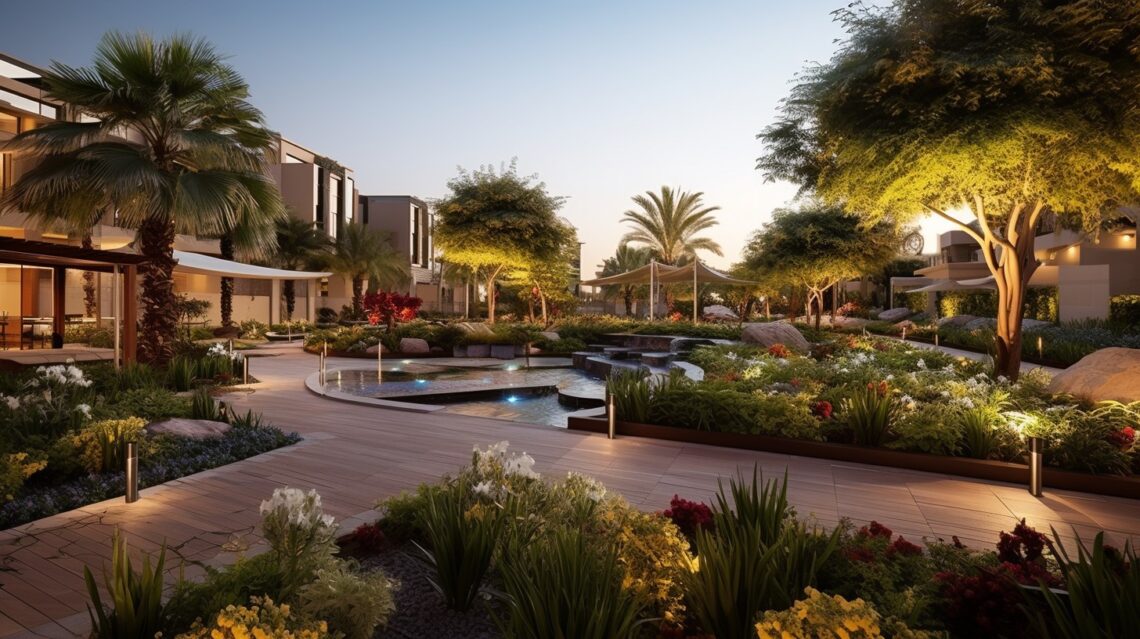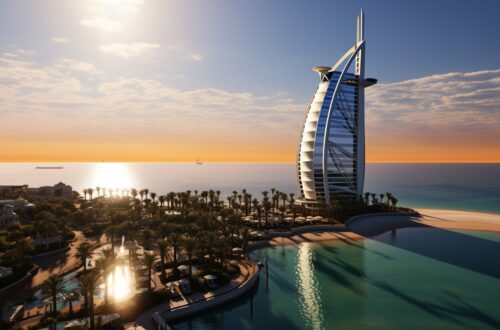Dubai, synonymous with luxury and innovation, stands at the forefront of a global challenge: climate change. In this desert metropolis, where futuristic skyscrapers meet ancient traditions, the effects of climate change are not just a distant threat but a present reality. Understanding how this global phenomenon impacts Dubai’s unique environment offers a glimpse into the city’s resilience and adaptability to environmental challenges.
Introduction to Climate Change in Dubai
Climate change, a global issue, poses specific challenges for Dubai, a city located in one of the world’s harshest desert climates. The city’s rapid development and unique geographical position make it particularly susceptible to the effects of global warming. In Dubai, climate change is not an abstract concept; it’s a reality that influences everyday life, from soaring temperatures to changing rainfall patterns. As a hub of international business and tourism, the world closely watches Dubai’s response to these challenges.
Historical Climate Patterns and Recent Changes
Analysis of Historical Weather Data in Dubai
Historically, Dubai has experienced a hot desert climate, with high temperatures and minimal rainfall. However, recent decades have seen a noticeable shift. Data from the UAE’s National Center of Meteorology indicates an increase in average temperatures over the last 30 years. Notably, summer temperatures have frequently exceeded the average, with peaks sometimes reaching up to 50°C (122°F). Such extreme weather conditions pose significant challenges to the environment and the city’s infrastructure.
Recent Trends in Temperature and Rainfall Patterns
Recent years have also witnessed fluctuations in rainfall patterns in Dubai. While the region typically experiences low rainfall, current data suggests an increase in erratic rainfall events, leading to occasional flooding in a city not naturally equipped to handle excessive rainwater. These changing patterns can be attributed to the broader impacts of climate change, altering weather systems and precipitation levels globally.
Impact of Climate Change on Dubai’s Natural Environment
Rising Temperatures and Their Effects on the Desert Ecosystem
The rising temperatures in Dubai pose a significant threat to its delicate desert ecosystem. The desert’s flora and fauna, adapted to a specific climate range, are now under stress due to these changing conditions. This cascades biodiversity and can lead to the loss of native species, further impacting the ecological balance.
Sea Level Rise and Its Impact on Coastal Areas
Another critical concern for Dubai, a city with a vast coastline, is the rising sea level. This phenomenon, caused by melting polar ice caps due to global warming, threatens coastal habitats and infrastructure. Iconic developments like the Palm Jumeirah and the World Islands, marvels of engineering built on reclaimed land, could face significant risks from rising sea levels. The potential impact on these landmarks is an environmental concern and a challenge for the tourism and real estate sectors, both vital to Dubai’s economy.
Case Study: The Impact on Dubai’s Iconic Palm Islands
The Palm Islands, one of Dubai’s most famous landmarks, are particularly vulnerable to the effects of climate change. These artificial islands, constructed primarily for residential and leisure purposes, have altered coastal dynamics and could face erosion and flooding as sea levels rise. Protective measures and sustainable planning are crucial to mitigate these risks and ensure the longevity of these iconic structures. Visitors to the Palm Islands can witness firsthand the blend of luxury and innovation while observing the challenges climate change poses to such ambitious projects.
Climate Change and Urban Development
Dubai’s urban development, characterized by rapid growth and architectural marvels, contributes significantly to combating climate change. The city’s transformation from a modest fishing village to a towering metropolis has been accompanied by increased carbon emissions and energy consumption, exacerbating the effects of global warming. However, Dubai is also at the forefront of adopting innovative strategies to mitigate these impacts.

How Urbanization Has Contributed to Climate Change in Dubai
Urbanization in Dubai has led to increased energy demand, primarily due to air conditioning, which is indispensable in the city’s hot climate. The construction boom, characterized by glass-covered skyscrapers, has intensified the urban heat island effect, where built-up areas are significantly warmer than surrounding rural areas. This phenomenon increases energy consumption for cooling and exacerbates the discomfort during the already sweltering summer months.
Additionally, the reliance on fossil fuels for energy production and the extensive use of private vehicles contribute significantly to Dubai’s carbon footprint. The city’s sprawling layout and the preference for car travel have increased greenhouse gas emissions, contributing to global climate change.
Efforts to Make Urban Areas More Climate Resilient
In response to these challenges, Dubai has initiated several measures to make its urban areas more climate-resilient. The city is investing in green infrastructure, such as developing parks and green spaces, to mitigate the urban heat island effect. These areas provide recreational spaces for residents and contribute to lowering city temperatures.
Dubai’s long-term strategy also includes transitioning to sustainable transportation. Expanding the Dubai Metro and introducing electric buses are steps towards reducing the city’s reliance on cars, aiming to lower traffic-related emissions.
Case Study: Sustainable Development Initiatives in The Sustainable City
The Sustainable City in Dubai is a model for environmentally conscious urban development. This residential area is designed to minimize its ecological footprint, featuring solar-powered homes, extensive green spaces, and a ban on fossil fuel vehicles within the community. The city’s approach to sustainable living extends to water conservation, with recycling and reuse systems in place, waste reduction through composting, and sustainable waste management practices.
The Sustainable City is not just a residential area; it’s a living laboratory for sustainable urban development. Visitors can explore the community, experiencing its organic farms, green homes, and innovative waste management systems. This development demonstrates how urban areas can adapt to the challenges of climate change while maintaining high living standards.
Dubai’s Initiatives to Combat Climate Change
As a city in a harsh desert climate, Dubai faces unique challenges due to climate change. However, it is also a city of innovation and resilience, actively implementing initiatives to combat the effects of climate change and promote environmental sustainability.
Renewable Energy Projects and Green Building Standards
One of Dubai’s key areas of focus is the development of renewable energy projects. The Mohammed bin Rashid Al Maktoum Solar Park, one of the largest solar parks in the world, exemplifies Dubai’s commitment to reducing its dependence on fossil fuels. This massive project aims to produce thousands of megawatts of solar power, significantly contributing to the city’s energy needs and reducing carbon emissions.
In addition to renewable energy projects, Dubai has implemented green building standards across the city. These standards require new buildings to incorporate energy-efficient designs, use sustainable materials, and implement water-saving techniques. These measures reduce the environmental impact of buildings and lower operational costs, making them economically viable in the long term.
Water Conservation and Management Strategies
Given Dubai’s arid climate and limited natural water resources, water conservation is another critical area of focus. The city has implemented advanced water management strategies, including using treated wastewater for irrigation and landscaping. Dubai also invests in desalination technology, turning seawater into potable water, though this process is energy-intensive and has environmental challenges.
The Role of Public Awareness and Education
Public awareness and education are essential to Dubai’s strategy to combat climate change. The city conducts various programs and campaigns to educate residents and visitors about sustainable practices, such as water and energy conservation, recycling, and the importance of public transportation. These initiatives aim to foster a culture of environmental responsibility among the population, ensuring that the fight against climate change is a collective effort.
In conclusion, Dubai’s response to the challenges posed by climate change is multifaceted, involving significant shifts in urban development, energy production, and public awareness. As a city known for its adaptability and innovation, Dubai’s efforts to combat climate change set an example for other cities facing similar environmental challenges. The final sections of this article will further explore the challenges and prospects of Dubai’s climate and environmental health, offering insights into the city’s continued efforts to balance development with sustainability.

Challenges and Future Prospects
While pioneering in its approach to combating climate change, Dubai faces challenges that test its resilience and adaptability. Balancing rapid urbanization with environmental sustainability, addressing the city’s carbon footprint, and coping with the inherent vulnerabilities of its geographical location are just a few of the hurdles Dubai must overcome.
Balancing Rapid Urbanization with Environmental Sustainability
Dubai’s remarkable urbanization, marked by towering skyscrapers and vast infrastructure projects, has been a double-edged sword. On the one hand, it has propelled the city onto the global stage as a symbol of modernity and progress. On the other hand, this rapid development has escalated environmental concerns, primarily regarding energy consumption and greenhouse gas emissions.
While iconic, the city’s architectural wonders contribute significantly to its energy demands. For instance, the extensive use of glass in buildings exacerbates the heat island effect, necessitating more energy for cooling. Moreover, the city’s sprawling nature encourages car dependency, further adding to its carbon emissions.
Dubai has initiated green building codes to address these challenges and actively promotes public transport and sustainable mobility options. However, the real test lies in integrating these initiatives seamlessly into the fabric of city life while continuing its growth trajectory.
Projections for Dubai’s Climate and Environmental Health in the Future
Looking ahead, Dubai faces a future where the impacts of climate change could become more pronounced. Rising temperatures and irregular weather patterns, including the potential for more extreme weather events, threaten the city’s environmental health and the well-being of its residents.
The city’s reliance on desalination plants for its water supply is another concern, especially as these plants are energy-intensive and contribute to greenhouse gas emissions. As global temperatures rise, the water demand is expected to increase, putting additional strain on these resources.
However, it’s not all bleak. Dubai’s investments in renewable energy, particularly solar power, are steps towards a more sustainable future. The Mohammed bin Rashid Al Maktoum Solar Park is a testament to this commitment, and its expansion will be crucial in meeting the city’s future energy demands while reducing its carbon footprint.
Conclusion
In conclusion, Dubai’s journey in addressing climate change is complex yet fascinating. From its ambitious urban development to pioneering sustainability initiatives, the city presents a unique case study balancing growth with environmental responsibility.
As a tourist or a resident, witnessing Dubai’s transformation and its response to climate change offers valuable insights into the challenges and opportunities modern cities face in the era of global warming. The city’s efforts in renewable energy, sustainable urban planning, and public awareness campaigns serve as necessary steps toward mitigating the impacts of climate change.
Dubai’s story is one of innovation, resilience, and adaptability. As the world grapples with the realities of climate change, the city’s experiences offer lessons in navigating the complexities of environmental sustainability in an ever-changing global landscape. As we progress, Dubai’s continued commitment to addressing climate change will be critical in shaping its future as a sustainable, vibrant, and resilient city.





